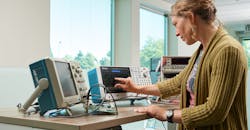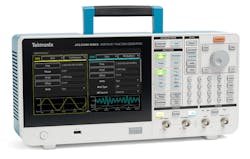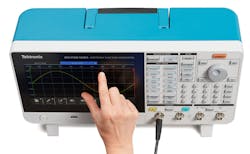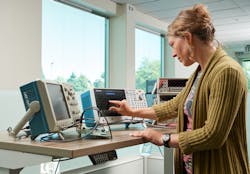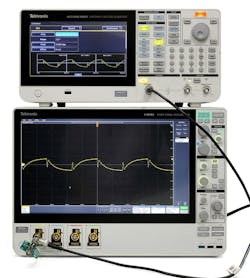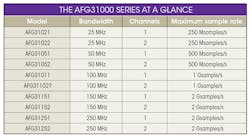Test signals are becoming more complex with the components and systems they characterize. Although such signals are needed to evaluate the performance of an expanding array of electronic devices, generating the necessary test signals—with advanced modulation—is often the most difficult part of running a device under test (DUT) through a required set of measurements.
Fortunately, the instrument developers at Tektronix are also users of test equipment, and a great deal of that personal touch can literally be found in the company’s latest arbitrary function generators (AFGs), the AFG31000 series. The AFGs use a touchscreen to create almost any kind of test signal waveform or sequence of waveforms.
This line of compact one- and two-channel test signal sources with signal bandwidths to 250 MHz combine high performance, usability, and flexibility, essentially bringing complex test signal waveforms “down to earth.” The AFGs show all of the details on the industry’s largest display screen in this class of instrument: a 9-in. (diagonal) capacitive touchscreen that, when teamed with a new user interface, helps speed and simplify the creation of the test signal waveforms needed to evaluate the latest electronic devices and systems.
1. The AFG31000 Series of arbitrary function generators (AFGs) combine precise signal-generation power with an intuitive user interface for ease of control.
The different members of the AFG31000 series of AFGs share the large display screen and intuitive user interfaces on their front panels (Fig. 1). They leverage the handy capacitive touchscreens to ease instrument control and measurement programming as well as real-time waveform monitoring (Fig. 2).
2. A large capacitive touchscreen helps in creating and monitoring waveforms and sequences of waveforms.
The test signal sources can operate in two operating modes: Basic and Advanced modes. The Basic mode can be thought of as a simple means of creating traditional waveforms, such as sinewaves or pulse trains, as well as defining arbitrary waveforms. The Advanced mode is for more elaborate sequences that may combine different waveforms and complex signals that could require some measure of programming. Still, the Basic mode does enable some useful degree of tuning that can aid certain measurements; for example, in Basic mode, it is possible to change frequency without changing waveform length or sample rate, which is useful when characterizing analog filter circuits.
Advanced Mode
To generate the complex waveform patterns typically associated with an arbitrary waveform generator (AWG), many users will explore the Advanced operating mode of these signal sources, exploiting its capabilities of orchestrating multiple waveforms with complex timing.
It will take quite an ambitious user to exceed the memory storage limits of the AFG31000 series, since these instruments incorporate enough waveform memory to store a list or sequence of waveforms from 1 to as many as 256 waveforms. Standard memory supports waveform length to 16 Mpoints/channel for those 256 waveforms, and as much as 128 Mpoints/channel memory is available as an option for one- or two-channel models.
Creating sophisticated sequences of waveforms takes time and will depend on the requirements of a particular DUT and its applications. However, the AFGs include functions such as repeat, wait, and jump to help speed and simplify the waveform/sequence creation process.
For establishing sequences of precisely controlled, individual waveforms, the Advanced mode incorporates variable-sample-rate technology. Every sample in a waveform is output once during each cycle of the waveform and synchronized to the sample rate for that waveform and/or test signal sequence. Since waveforms are not copied or duplicated, even the smallest differences between similar waveforms are preserved and all of the details of a complex sequence of waveforms are maintained. The Advanced mode is extremely useful for generating and saving unique waveforms, such as degenerative pulse trains or specialized versions of in-phase/quadrature (I/Q) signal modulation in high-data-rate communications links.
Providing Performance
The AFG31000 series is designed to simplify the generation of complex waveforms, but they don’t skimp on performance. Waveforms can be created with as much as 14-b vertical resolution and with sample rates of 250 Msamples/s, 500 Msamples/s, 1 Gsample/s, or 2 Gsamples/s to define the most imaginative wave shapes. Sampling clocks can be set across a wide range of rates, from 1 µsample/s to 2 Gsamples/s.
Output signal are delivered across an amplitude range of 1 to 10 V p-p into 50-Ω loads. For those who may just need a traditional test signal for the moment, the AFGs also provide a host of built-in waveforms available with the push of a button, including sinewaves, square waves, ramps, pulses, and noise outputs. Standard modulation formats are quickly available, too, including amplitude modulation (AM), frequency modulation (FM), phase modulation (PM), frequency shift keying (FSK), and pulse-width modulation (PWM).
3. The usability provided by the capacitive touchscreen minimizes the need for an additional controller PC.
Combined with their precise and accurate waveforms, the flexible control offered by the AFGs’ capacitive touchscreens (Fig. 3) will provide a strong invitation for many engineers to try their hand (again, literally) at creating a required waveform or sequence of similar or different waveforms. For those comfortable with building a test waveform based on the measurement acquisitions of an oscilloscope, the AFG31000 series AFGs can also directly load .csv signal-acquisition files saved from an oscilloscope (Fig. 4) to replicate those waveforms on one of the AFG31000 AFGs.
4. The AFG31000 Series AFGs can work with .csv files from an oscilloscope to duplicate the waveforms captured earlier by the oscilloscope.
The AFGs come with one or two channels and many choices of performance levels (see table). However, all share the usability of the capacitive touchscreen and powerful measurement software to make the task of waveform generation a bit easier.
For example, the patented, built-in InstaView technology allows operators to see what a test signal waveform looks like at a DUT. It even includes the amplitude and phase effects of interconnecting cables and connectors (which are added), without connecting an oscilloscope. The built-in multiple-unit sync, as a step-by-step wizard, also helps make a simple task of synchronizing multiple AFG31000 AFGs or other signal sources when extremely complex test signal waveforms are needed.
The PC that up to now has been required to configure waveforms on AFGs is not needed with the AFG31000 instruments, which include ArbBuilder software to create and edit arbitrary waveforms. For educational purposes, the AFGs are compatible with the company’s TekBench software to allow students and engineers alike opportunities for studying created waveforms and sequences of waveforms. P&A: $2,210 and up.
Tektronix Inc., 14150 SW Karl Braun Dr., P. O. Box 500, Beaverton, OR 97077; (800) 833-9200.
About the Author
Jack Browne
Technical Contributor
Jack Browne, Technical Contributor, has worked in technical publishing for over 30 years. He managed the content and production of three technical journals while at the American Institute of Physics, including Medical Physics and the Journal of Vacuum Science & Technology. He has been a Publisher and Editor for Penton Media, started the firm’s Wireless Symposium & Exhibition trade show in 1993, and currently serves as Technical Contributor for that company's Microwaves & RF magazine. Browne, who holds a BS in Mathematics from City College of New York and BA degrees in English and Philosophy from Fordham University, is a member of the IEEE.
